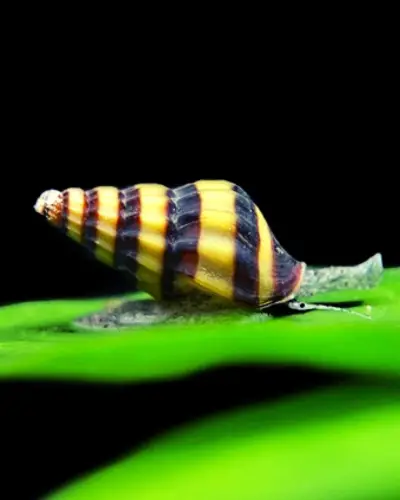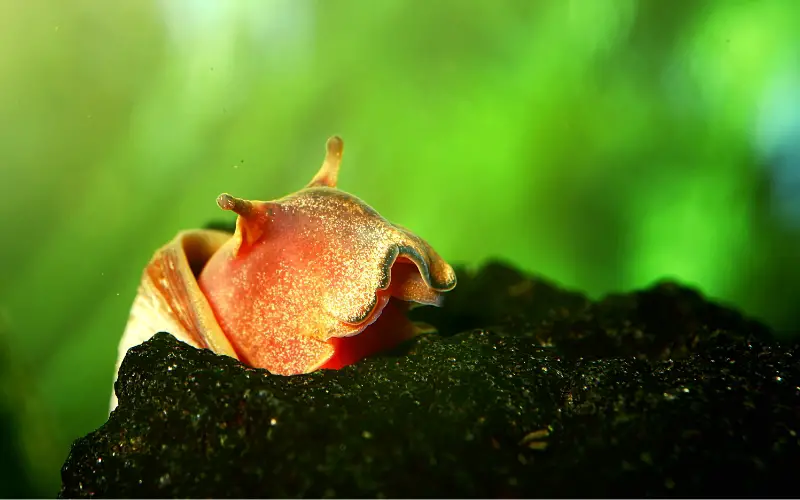Assassin snails, known for their unique appearance and predatory nature, have become popular additions to freshwater aquariums. While many hobbyists value these snails for their ability to control pest snail populations, there must be clarity surrounding their diet regarding algae. Do assassin snails eat algae?
In this article, we will explore the feeding habits of assassin snails and whether or not they consume algae as part of their diet.
Understanding what these snails eat is essential for maintaining a balanced ecosystem in your aquarium and ensuring the health and well-being of your aquatic pets.

So, if you’re curious whether assassin snails can help keep your tank clean of algae or if you need to look for alternative solutions, keep reading to find out more.
Table of Contents
ToggleAre Assassin Snails Carnivorous?
Yes, assassin snails are carnivorous and are known to eat a variety of smaller snails, including Malaysian trumpet snails, pond snails, and nerite snails. They are invertebrate feeders and consume dead fish, brine shrimp, and even snail eggs.
In a planted tank, assassin snails can help control snail population explosions by preying on the smaller snails that inhabit the substrate.
Keeping a close eye on the snail population in your tank is recommended to ensure that the assassin snails do not run out of food. They also like algae wafers since they are known to eat the algae that may turn to algae wafers in the tank.
Since assassin snails prefer eating snails and have nothing else to eat, they may also like algae wafers since they eat often the algae that grow on the tank as assassin snails. In addition to snails, they are also known to eat snail’s shells to get the nutrients they need.
Assassin snails spend most of their time hunting for snails in the tank and can help keep the snail population under control. They are a great choice for any tank as they help maintain the water quality by preying on unwanted snails.
Do Assassin Snails Eat Algae in Aquariums?
The clea helena, also known as assassin snails, are carnivorous freshwater gastropods often sought after in the aquarium hobby. While their favorite foods include larger snails and carrion, they can also eat algae wafers and supplement their diet with fish flakes.
Some aquarists may introduce assassin snails into their tanks to help clean the tank of pest snails like ramshorn or nerites. However, it is essential to note that assassin snails may harm small fish, or snails can live in the tank.
In terms of assassin snail breeding, they lay their eggs in clutches, often hidden in live plants. These snails prefer eating algae but often eat uneaten food in the tank.
It is not uncommon for assassin snails to accidentally eat small fish that share their tank, as they may mistake them for their usual prey. The optimal water parameters for assassin snails are similar to those of most freshwater fish species, making them reasonably easy to care for.
They thrive in tanks with plenty of hiding spots, like rocks or plants in the tank, where they can spend time buried.
Assassin snails can multiply quickly with an abundant food source, so be mindful of their population in your tank. These snails are especially useful for controlling populations of other pest snails like bumblebees or anentome.
Are Freshwater Snails Harmful?
Freshwater snails themselves aren’t inherently harmful. They can be beneficial for aquariums, eating algae and detritus. However, there’s one big caveat: certain species of freshwater snails can carry a parasitic disease called schistosomiasis.

Schistosomiasis is a severe disease affecting millions worldwide, particularly in tropical and subtropical regions.
It’s caused by parasitic worms that live in certain freshwater snails. The parasites release larvae into the water, which can penetrate human skin during contact. This can lead to a variety of health problems, including abdominal pain, diarrhea, blood in the stool, and even organ damage.
So, while freshwater snails aren’t harmful, it’s essential to be aware of the risk of schistosomiasis, especially if traveling to areas where the disease is common. Here are some ways to reduce your risk:
- Avoid swimming or wading in freshwater, especially in stagnant water conditions.
- Wear shoes or sandals when walking in areas near freshwater.
- Drink treated water only.
- If you come into contact with freshwater, wash your skin thoroughly with soap and clean water afterward.
If you’re concerned about schistosomiasis, talk to your doctor before traveling to an area where the disease is common. They can advise you on additional precautions you can take.
Keeping Assassin Snail Care Guide
Assassin snails can be a helpful addition to your tank if you want to control other snail populations. Here’s a quick guide on keeping them happy and healthy:
Habitat:
- Tank size: Assassin snails can thrive in tanks as small as 5 gallons, but a 10 gallon is ideal.
- Water parameters: They prefer stable conditions with a pH of 7.0-8.0, a temperature between 68 degrees Fahrenheit (20°C-27°C), and moderately hard water. Avoid copper-based treatments as they can be harmful to snails.
- Substrate: Soft sand or aqua soil is best. They like to burrow and hunt for prey in the substrate.
Diet:
- Assassin snails are carnivores. In the wild, they mainly eat other snails. If other snails aren’t in the tank, they’ll scavenge for leftover fish food and detritus.
- You can occasionally supplement their diet with blanched vegetables or sinking carnivore pellets.
Tankmates:
- Assassin snails are peaceful with fish but will prey on other snail species and shrimp. So avoid keeping them together if you cherish your fancy snails or shrimp colony.
Breeding:
- Assassin snails are hermaphrodites, so you only need one to have a breeding population potentially.
- They lay eggs in white sacs attached to the aquarium glass. The eggs will hatch into miniature versions of the adults.
Additional Tips:
- Maintain good water quality with regular partial water changes.
- Assassin snails can live for 2-3 years.
- They’re nocturnal, so you might not see them much during the day.
For more in-depth information, you can check out these resources:
- Assassin Snail Care Guide: [aquarium care basics assassin snail ON Aquarium Care Basics
- Assassin Snail Care Guide & Tank Set Up For Beginners: assassin snail tank setup
What Tank Mates Should You Get for My Assassin Snail?
Assassin snails are peaceful creatures that are great additions to any freshwater aquarium. When considering tank mates for your assassin snail, choosing species that won’t harm the snail or become pests in the tank is important.
One option is to add algae eaters, such as catfish or cichlids, as they can help keep the tank clean and provide food for the snails. Another option is adding pufferfish or clown loaches, known to eat assassin snail eggs.
Additionally, since assassin snails spend most of their time on the substrate, they can be housed with meaty breeders such as blood worms. Overall, choosing tank mates that will coexist peacefully and help maintain a healthy tank environment is essential.
Commonly Asked Questions about Assassin Snails Eat Algae in Tanks (FAQs)
Do assassin snails need sand?
Assassin snails don’t require sand but prefer it for burrowing and hiding. They can adapt to gravel, but sand helps them hunt prey and reduces stress.
Do assassin snails eat brown algae?
Do assassin snails eat algae? Assassin snails aren’t algae eaters. They mainly target other snails but may nibble on algae if hungry. Consider algae-eating fish or snails for brown algae control.
How often do you see your assassins eating up a shrimp?
It’s rare to see assassins hunt healthy shrimp. They target weak, injured, or molting shrimp. Consider feeding assassins well to minimize shrimp predation.
What makes assassin snails the ideal exterminator for pest snails?
Assassin snails are ideal exterminators for pest snails due to their predatory nature, as they actively hunt and consume other snails, effectively controlling their population.
How do you control the trumpet snail population?
Reduce trumpet snail food source: feed fish less & clean up excess waste. Manually remove or use traps. Consider snail-eating fish (pea puffers) for aquariums.
What snails can be used to control snail populations in aquariums?
Assassin snails, dwarf chain loaches, and pufferfish can be used to control snail populations in aquariums by preying on and consuming the pest snails.
What will assassin snails eat if there are no snails?
Assassin snails will scavenge for algae, biofilm, leftover fish food, or even dead fish if their main prey is scarce.
Are assassin snails good for an aquarium?
Assassin snails are great for aquariums with pest snails! They control populations naturally but may eat shrimp and are not algae eaters.
Do assassin snails eat leftover fish food?
Yes, assassin snails will eat leftover fish food, but it’s not ideal. They need food high in protein for health, so offer them other foods like blanched veggies or occasional bloodworms.
Conclusion
Assassin snails are known for their ability to control pest snail populations in aquariums, but did you know that they also play a role in keeping algae growth in check? While they primarily feed on other snails, assassin snails have also been known to consume algae. Their dark brown shells provide camouflage in their natural habitat and allow them to blend in with their surroundings.
In addition to being effective algae eaters, assassin snails are also a great source of protein for other fish in the tank. Their eggs are laid individually and are easily hidden among the gravel or substrate. Despite their predatory nature, assassin snails are not known to harm fish unless they are very small or sick. So, do assassin snails eat algae? Overall, keeping assassin snails in your tank can help maintain a clean tank by controlling both pest snails and algae.
You might also like
- Do Assassin Snails Eat Shrimp: The Ultimate Coexisting Guide
- How Do Assassin Snails Kill: Unveiling Their Deadly Secrets!
- What Do Assassin Snails Eat: A Comprehensive Feeding Guide
- Assassin Snail Breeding 101: A Comprehensive Beginners Guide
- Assassin Snail 101: Comprehensive Aquarium Guide (Exclusive)
- Will Assassin Snails Kill Mystery Snails: (Myths & Facts)
- How Fast Do Assassin Snails Breed in Tanks: (Ultimate Guide)




